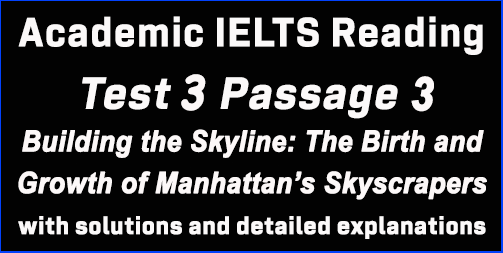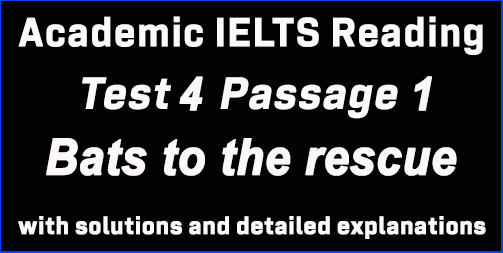IELTS Academic Reading: Test 3 Passage 3; Building the Skyline: The Birth and Growth of Manhattan’s Skyscrapers; with top solutions and best explanations
This Academic IELTS Reading post provides a complete set of solutions for Reading Test 3, Passage 3, titled ‘Building the Skyline: The Birth and Growth of Manhattan’s Skyscrapers’. It is especially designed for IELTS Academic candidates who often face challenges in locating and understanding correct answers in the Reading section. The explanations in this post aim to make each answer clear and easy to follow. Since mastering IELTS Reading requires a step-by-step approach, this guide will support you throughout that process with detailed and simple explanations.
Reading Passage 3:
The headline of the passage: Building the Skyline: The Birth and Growth of Manhattan’s Skyscrapers
Questions 27-31: Multiple choice questions
[This type of question asks you to choose a suitable answer from the options using the knowledge you gained from the passage. This question type generally follows a sequence. So, scanning skills are effective here.]
❓ Question 27: What point does Shester make about Barr’s book in the first paragraph?
🔎 Passage reference: Paragraph 1, Lines 2–3
“The book combines geology, history, economics, and a lot of data to explain why business clusters developed where they did…”
📝 Explanation:
The phrase “combines geology, history, economics” shows that Barr uses many different factors to explain New York’s skyline.
👍🏼 Synonym match:
“combines geology, history…” = “range of factors”
“affected the development of New York” = “shaped the skyline”
✅ Answer: D. It covers a range of factors that affected the development of New York.
❓ Question 28: How does Shester respond to the information in the book about tenements?
🔎 Passage reference: Paragraph 3, Lines 3–5
“I would have liked Barr to expand upon his claim that existing tenements prevented skyscrapers…”
📝 Explanation:
Shester (the reviewer) says she wanted more details about this topic. This shows she saw a problem or weakness in how the topic was treated.
👍🏼 Synonym match:
“would have liked… to expand” = indicates a problem or lack of detail
✅ Answer: B. She indicates a potential problem with Barr’s analysis.
❓ Question 29: What does Shester say about chapter six of the book?
🔎 Passage reference: Paragraph 7, Lines 4–5
“While less technical than the research paper on which the chapter is based, it is probably more technical than would be preferred by a general audience.”
📝 Explanation:
This means chapter 6 is quite technical and may not be suitable for everyone, especially general readers.
👍🏼 Synonym match:
“more technical than would be preferred” = “too specialized”
✅ Answer: C. It is too specialized for most readers.
❓ Question 30: What does Shester suggest about the chapters focusing on the 1920s building boom?
🔎 Passage reference: Paragraph 8, Lines 2–3
“Chapter eight contains lengthy discussions of urban economic theory that may serve as a distraction to readers primarily interested in New York.”
📝 Explanation:
This suggests some readers may lose interest because of the technical content in these chapters.
👍🏼 Synonym match:
“distraction to readers” = “limited appeal”
✅ Answer: D. Some parts will have limited appeal to certain people.
❓ Question 31: What impresses Shester the most about the chapter on land values?
🔎 Passage reference: Paragraph 9, Line 2
“The data work that went into these estimations is particularly impressive.”
📝 Explanation:
This shows the reviewer was most impressed by the research and data collection process.
👍🏼 Synonym match:
“data work” = “nature of the research”
✅ Answer: C. The nature of the research into the topic.
Questions 32-35: YES, NO, NOT GIVEN
In this type of question, candidates are asked to find out whether:
The statement in the question matches with the claim of the writer in the text- YES
The statement in the question contradicts the claim of the writer in the text- NO
The statement in the question has no clear connection with the account in the text- NOT GIVEN
[TIPS: For this type of question, you can divide each statement into three independent pieces and make your way through to the answer. This question type generally follows a sequence. So, scanning skill is effective here.]
❓ Question 32: The description in the first chapter of how New York probably looked from the air in the early 1600s lacks interest.
🔎 Passage reference: Paragraph 2, Line 1
“Barr begins chapter one by… giving a fascinating account of how the New York landscape in 1609 might have looked…”
📝 Explanation:
The word “fascinating” means the opposite of “lacks interest.”
✅ Answer: NO
❓ Question 33: Chapters two and three prepare the reader well for material yet to come.
🔎 Passage reference: Paragraph 3, Line 2
“Both chapters are informative and well researched and set the stage for the economic analysis that comes later…”
📝 Explanation:
“Set the stage” means they prepare the reader for the content in later chapters.
✅ Answer: YES
❓ Question 34: The biggest problem for many nineteenth-century New York immigrant neighborhoods was a lack of amenities.
🔎 Passage reference: Paragraph 4, Lines 2–3
“Barr identifies four primary immigrant enclaves and analyzes their locations in terms of the amenities available…”
📝 Explanation:
The passage mentions amenities but does not say a lack of them was the biggest problem.
✅ Answer: NOT GIVEN
❓ Question 35: In the nineteenth century, New York’s immigrant neighborhoods tended to concentrate around the harbor.
🔎 Passage reference: Paragraph 4, Line 4
“Most of these enclaves were located… between the industries located on the waterfront and the wealthy neighborhoods bordering Central Park.”
📝 Explanation:
They were between the waterfront and elite areas — not concentrated around the harbor.
✅ Answer: NO
Questions 36 – 40: Completing summary with a list of words:
[In this type of question, candidates are asked to complete a summary with a list of words taken from the passage. Candidates must write the correct letter (not the words) as the answers. Keywords and synonyms are important to find answers correctly. Generally, this type of question maintains a sequence. Find the keywords in the passage and you are most likely to find the answers.]
Title of the summary: The bedrock myth
❓ Question 36: In chapter seven, Barr indicates how the lack of bedrock close to the surface does not explain why skyscrapers are absent from ____________.
🔍 Passage reference: Paragraph 7, Lines 1–2
“Chapter seven tackles the ‘bedrock myth’… Rather, Barr argues that while deeper bedrock does increase foundation costs… this does not account for the absence of skyscrapers between Downtown and Midtown New York…”
📝 Explanation:
The question uses “absent from…” which matches “absence of skyscrapers between Downtown and Midtown.” These are specific areas.
👍🏼 Synonym match:
“absence from” = “absence of skyscrapers”
“between Downtown and Midtown” = “specific areas”
✅ Answer: H. specific areas
❓ Question 37: He points out that although the cost of foundations increases when bedrock is deep below the surface, this cannot be regarded as ___________ .
🔍 Passage reference: Paragraph 7, Line 3
“…these costs were neither prohibitively high nor were they large compared to the overall cost…”
📝 Explanation:
“Prohibitively high” means too expensive, so Barr says the costs weren’t excessive.
👍🏼 Synonym match:
“cannot be regarded as excessive expense” = “neither prohibitively high”
✅ Answer: D. excessive expense
❓ Question 38: especially when compared to __________.
🔍 Passage reference: Paragraph 7, Line 3
“…nor were they large compared to the overall cost of building a skyscraper.”
📝 Explanation:
“Overall cost of building a skyscraper” is the same as total expenditure.
👍🏼 Synonym match:
“overall cost” = “total expenditure”
✅ Answer: I. total expenditure
❓ Question 39: A particular enjoyable part of the chapter was Barr’s account of how foundations are built. He describes not only how _________ are made possible by the use of caissons,
🔍 Passage reference: Paragraph 7, Line 4
“He describes the use of caissons, which enable workers to dig down for considerable distances…”
📝 Explanation:
“Dig down for considerable distances” refers to deep excavations. Caissons make them possible.
👍🏼 Synonym match:
“dig down for considerable distances” = “deep excavations”
✅ Answer: B. deep excavations
❓ Question 40: but he also discusses their _________ . The chapter is well researched but relatively easy to understand.
🔍 Passage reference: Paragraph 7, Line 5
“…Barr’s thorough technological history discusses not only how caissons work, but also the dangers involved.”
📝 Explanation:
“Dangers involved” clearly matches “associated risks.”
👍🏼 Synonym match:
“dangers involved” = “associated risks”
✅ Answer: F. associated risks
Click here for solutions to Passage 1: The thylacine
Click here for solutions to Passage 2: Palm Oil




Waterfront = around the harbour